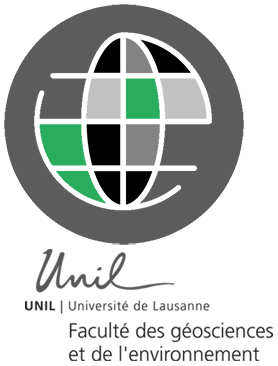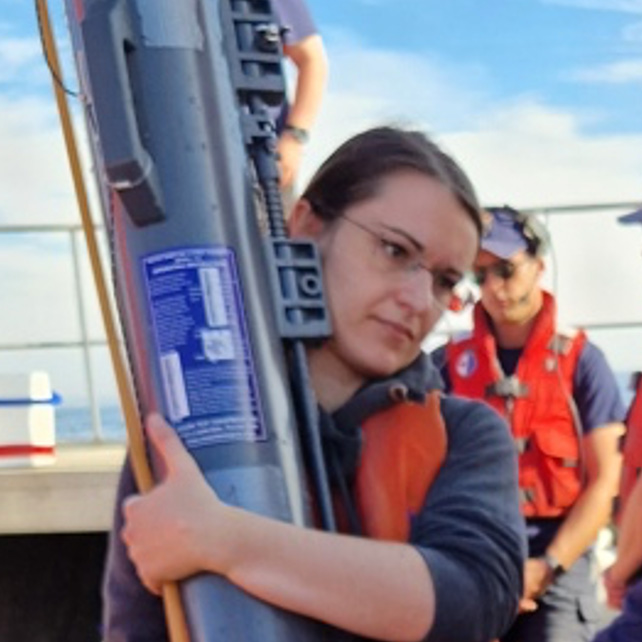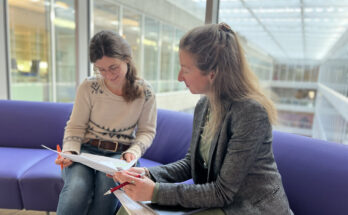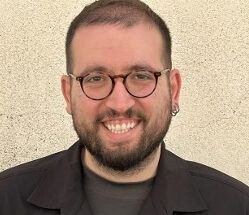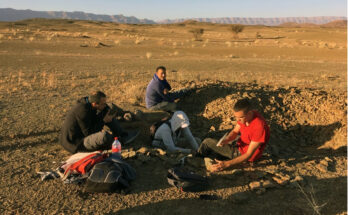Cette publication est également disponible en :
![]() Français
Français
Isabelle Baconnais, a member of the BOAT (Laboratory for Biological Oceanography Across Time, Institute of Earth Sciences, ISTE)research group, led a maritime expedition off the coasts of Vancouver in October 2022.
She collected seawater samples and suspended marine particles to measure their chromium content. Her objective is to ultimately determine whether this element could become a tracer of the activity of the marine biological pumps, which have an important role in the ocean carbon cycle.
These pumps help moving the atmospheric CO2 that dissolved in the surface waters towards the deep waters, thus helping to regulate the planet’s climate by trapping it into the Oceans for hundreds of years. A more precise quantification of the capacity of the biological pumps to transfer the CO2 towards the deep waters would allow to better predict their potential role in regulating the climate change.
The oceans cover more than 70% of the Earth’s surface. They have a significant influence on the climate, particularly through the absorption of atmospheric carbon dioxide (CO2), one of the main greenhouse gases. Photosynthetic microorganisms (phytoplankton) in surface waters use the dissolved CO2 to generate organic carbon, similarly to terrestrial plants. Phytoplankton are then ingested by other organisms, and some of this organic carbon “sinks” to the deeper waters as e.g. feces or dead bodies. The biological processes participating in the ocean carbon sequestration from the atmosphere are referred to as the biological carbon pump (BCP). This pump is essential for the climate balance. Since the beginning of the industrial era, it has already absorbed about a third of CO2 emissions related to e.g. the combustion of fossil fuels.
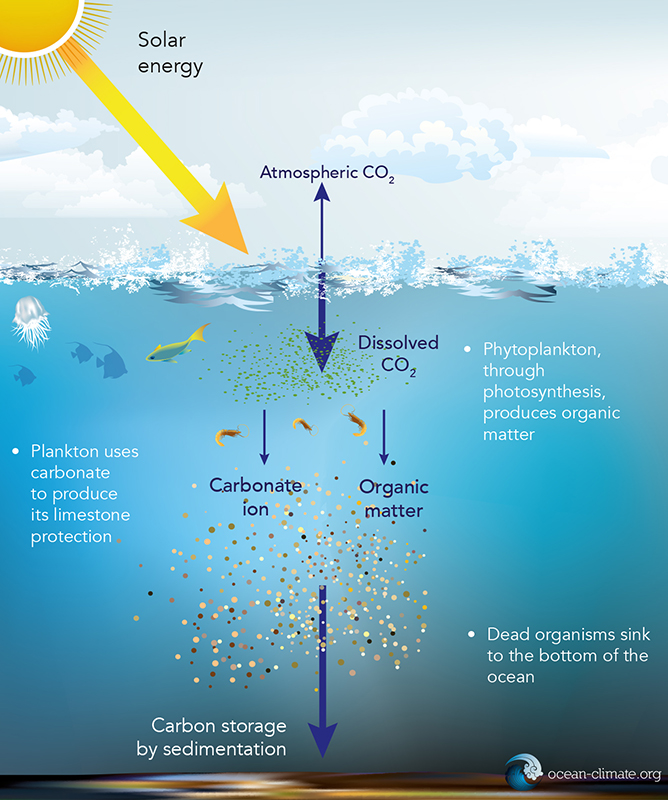
Several scientific teams have been trying to assess to what extent the activity of this BCP is, or could be, impacted by climate change and viceversa. Modelling of the carbon export is hampered by many uncertainties (e.g. change in the water masses circulation or variation in the nutrient inputs to the ocean). The direct use of carbon as a tracer of the BCP is limited by its ubiquitous presence in high concentrations in the oceans and by its use in various physical and biological processes (photosynthesis, respiration, dissolution etc…) that do not allow clear distinction and quantification of the processes specifically tied to the BCP.
Chromium has recently become of interest for its potential correlation with the transport of carbon to the deep waters of the modern oceans. However, no direct measurements of chromium in marine particles are currently available to confirm this suggestion (see note). Isabelle Baconnais is conducting research to fill this gap.
Below, the researcher describes her expedition off the coasts of Vancouver to collect samples of seawater and suspended marine particles (pictures from Maxime Curchod).
Autumn in Vancouver
In October 2022, we boarded the Canadian Coast Guard’s hovercrafts SIYAY and MOYTEL for six exciting days in the Strait of Georgia and Saanich Inlet in Canada’s Eastern Pacific. The Strait of Georgia is a dynamic waterway that separates the city of Vancouver from the picturesque Vancouver Island. Saanich Inlet is a partially anoxic fjord, with little to no dissolved oxygen in deep waters, within Vancouver Island.
The sampling site offered an excellent opportunity to collaborate with scientists from the University of British Columbia (UBC). The laboratory of Professor Roger François supplied the pumps used for the collection of the suspended marine particles. His team (i.e. Maureen Soon) also facilitated contact with the coast guards for the organization of the sampling trips. The equipment and experience provided on site greatly contributed to the success of this sampling expedition.
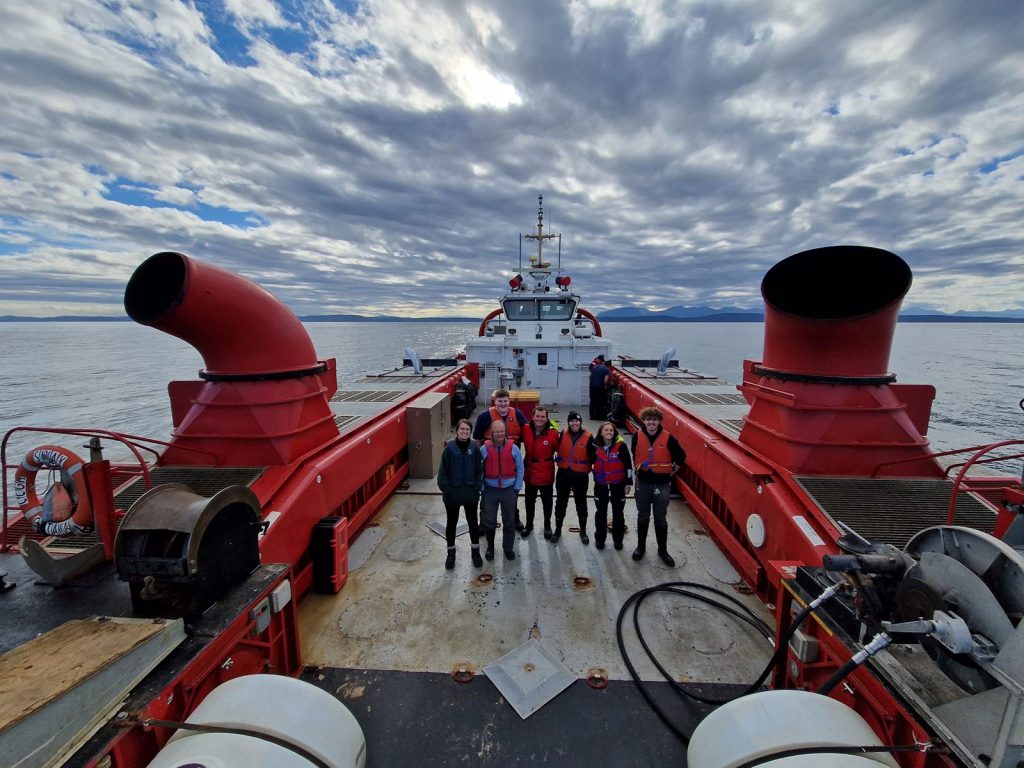
From left to right: Isabelle Baconnais, Ed ward Mason (UBC student, back), Roger François (UBC professor, front), Maxime Curchod (FGSEstudent), Lisa Kester, Nicole McHugh and Morgan Griffith (UBC students). Two members of the incredible Coast Guard team in the background.
Every morning, we arrive at the coast guard’s base to find the massive hovercraft waiting for us on the asphalt. Once the coast guards and scientists finish loading their respective equipment, the hovercraft inflates, and we are in our way in the blink of an eye. Its speed is such that it is forbidden to leave the cabin during transit, lest we be thrown overboard. In return, we quickly arrive on site and begin sampling in the crisp autumn morning of the Canadian West coast. We were particularly lucky regarding the weather since it was unusually sunny and warm for most of the expedition.
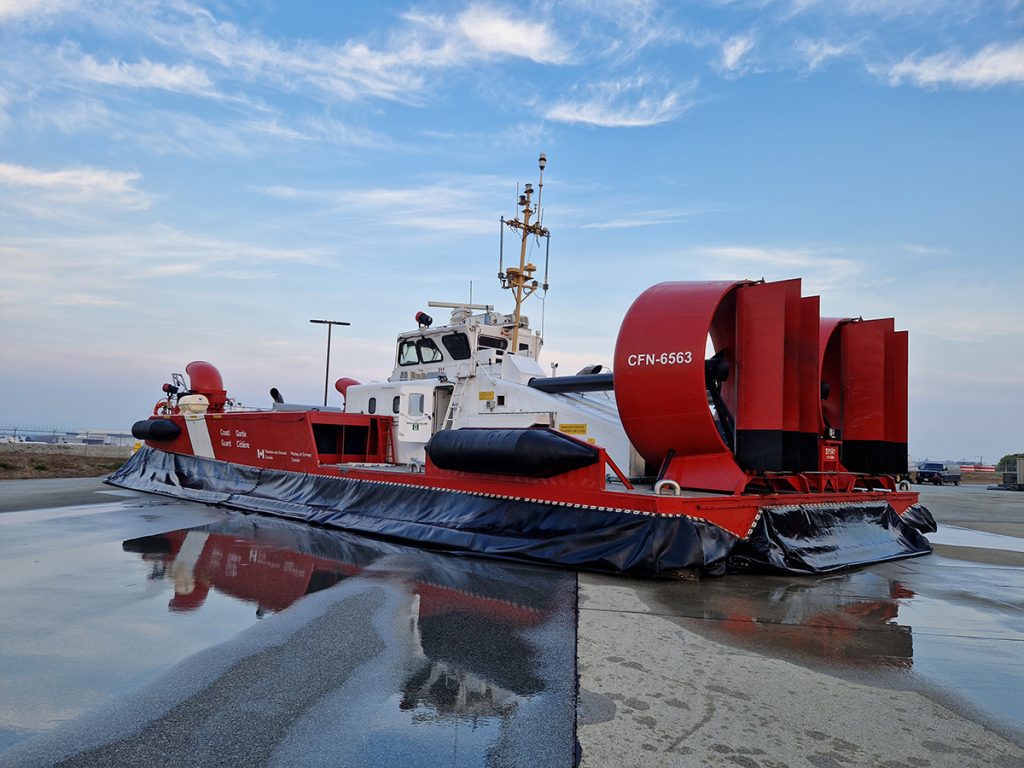
Using the Canadian coast guard’s hovercraft implies that rescue missions take precedence on the sampling. In case of an emergency call, all sampling device then needs to be quickly brought back onboard and secured as fast as possible. Fortunately, this only occurred once during the entire expedition, and in this instance, we were quickly able to get back to sampling.
Sampling at sea
Daily, we proceed to sampling under the curious gaze of the jumping salmons, the killer whales or the sea lions: we immerse the ~30 kg–large volume pumps at specific depths, through which hundreds of liters of water pass and allow the recovery of the suspended marine particles on filters. We also collect seawater in 20L bottles specifically designed for sampling for elements susceptible to contamination, called Go-Flo bottles. We distribute the water into bottles that will be used for different analyses (salinity and oxygen of the water, cadmium concentration, dissolved chromium concentration and isotopic analysis, particulate organic carbon concentration).
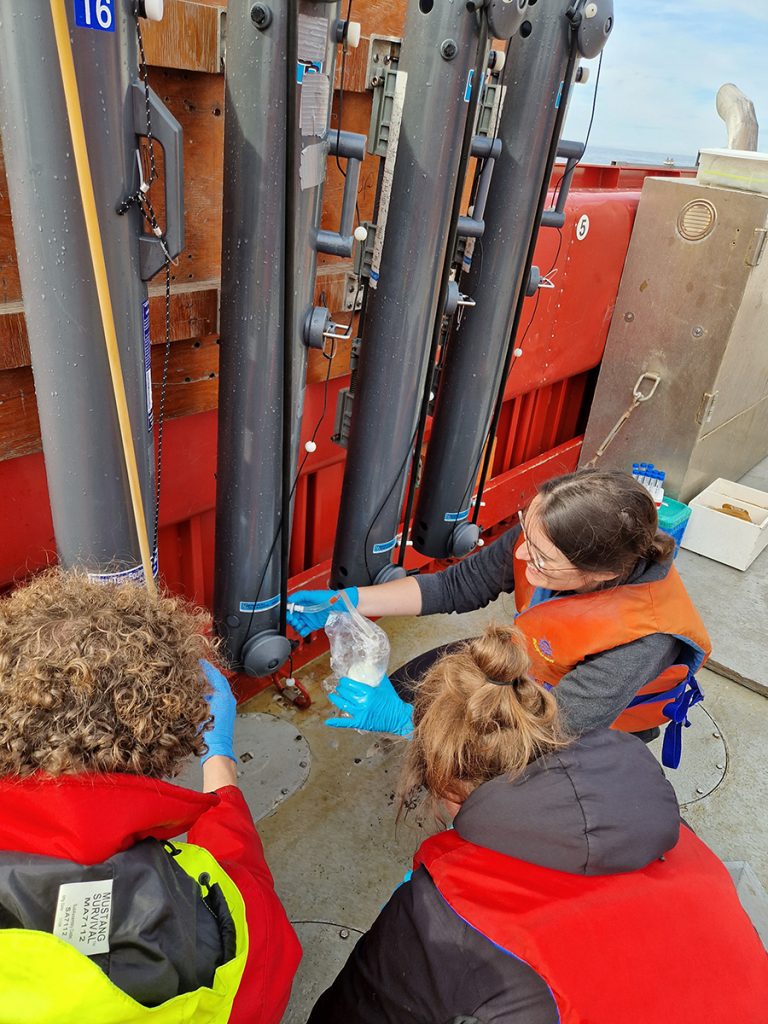
The unusually warm weather of the early autumn 2022 resulted in elevated biological activity. The filters recovered from surface waters testified to this, with their beige to greenish color and their sushi smell. The most notable sampling took place in the deep waters of Saanich Inlet, where the lack of oxygen could be surmised from the strong rotten egg smell emitted by the waters sampled. This smell is characteristic of the bacterial production of hydrogen sulphide H2S in anoxic environments.
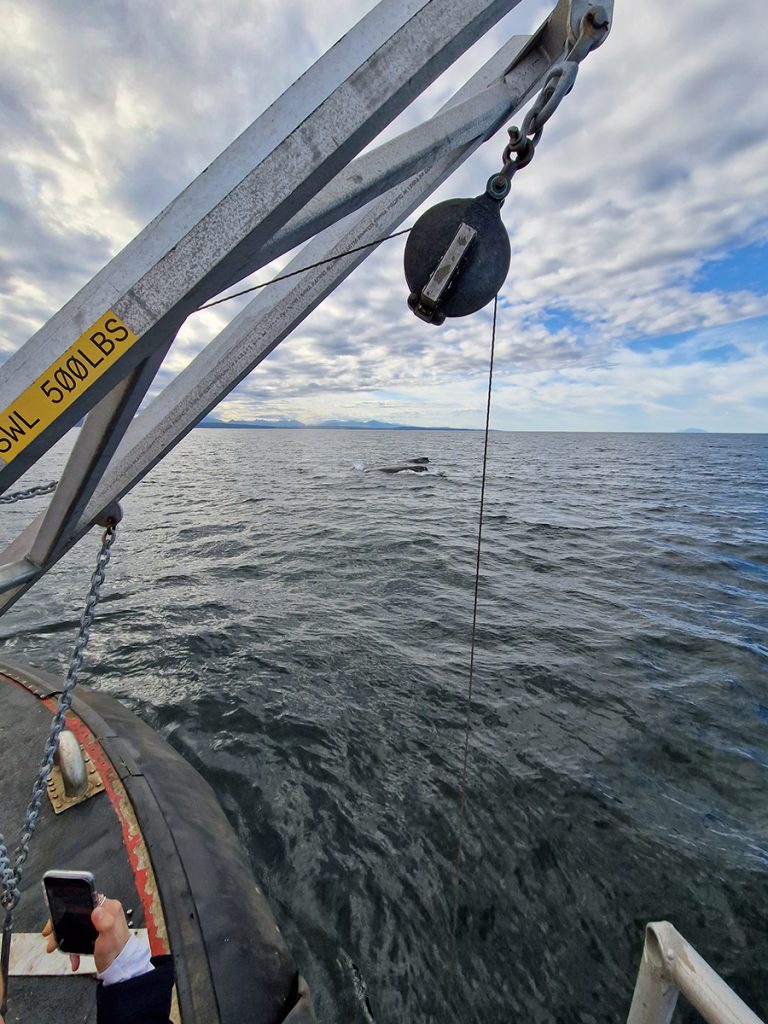
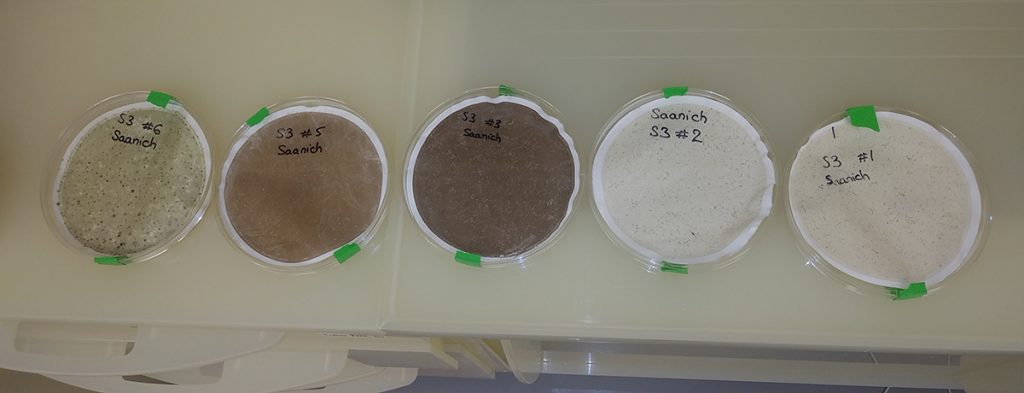
Why is chromium of interest?
Chromium is a trace element found in seawater in concentrations of the order of 0. 0000001 g per litre of seawater. Its concentration and isotopic ratios vary according to its distribution between chromium 6 (Cr(VI)) and chromium 3 (Cr(III)). Cr(VI) preferentially remains dissolved in seawater while Cr(III), isotopically lighter and formed from the natural reduction of Cr(VI), tends to adsorb onto marine particles.
The measurement of dissolved chromium concentrations and isotopic ratios has shown that chromium is lost in surface waters and remineralizes deeper in the oceans, which appear to be related to surface biological activity and the marine particle cycling. Direct measurements of chromium in marine particles are currently lacking to confirm these observations.
This study, and more broadly the SCriPT project (see ref. at the bottom of the article), aims to establish a method for measuring chromium concentration and isotopic ratios in marine particles in order to potentially use chromium as a tracer of the marine carbon flux to the deep waters, in other words, the oceanic BCP activity.
First objective achieved
Despite the several technical difficulties encountered during this trip (especially due to the fussy large volume pumps), the sampling was overall successful in both the quantity and the quality of the water and particles collected. It is now time to focus on measuring chromium and its isotopic ratios. Protocols do exist for measuring chromium dissolved in the waters, but they are yet to be established for measuring the chromium attached to the suspended particles. These samples represent the first steps towards a deeper understanding of the cycle of chromium in the oceans.
Chromium, which is not known to be used in biological processes, could become an excellent tracer of the particles that drive carbon from surface to deep waters, and therefore an indicator of the changes in the BCP brought upon by climate change.
For more information
This study is part of the European research project Horizon2020 SCrIPT Stable Chromium Isotopes as a Productivity Tracer (project obtained by Professor Samuel Jaccard of ISTE)
